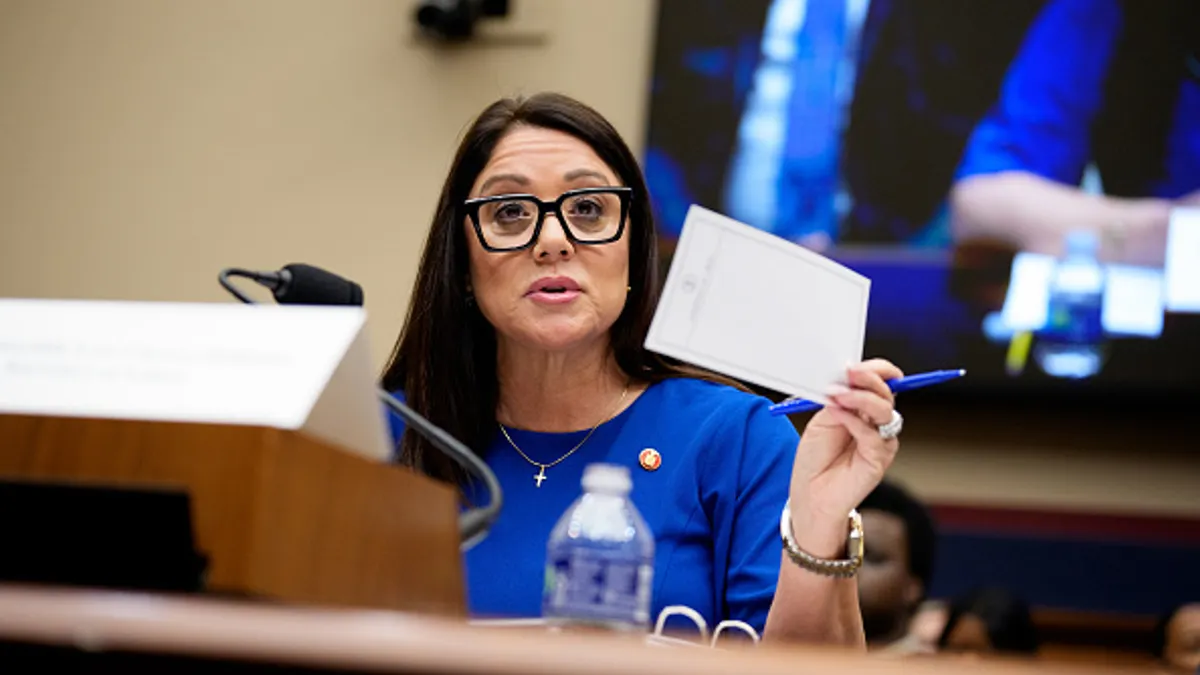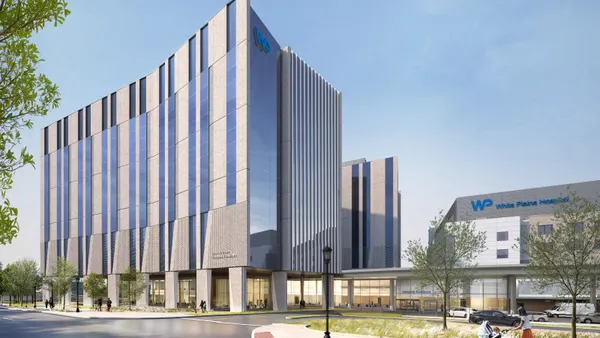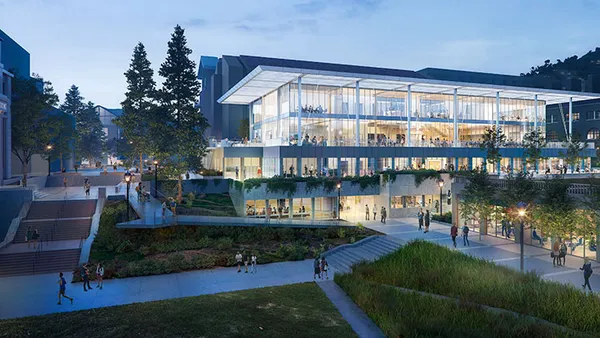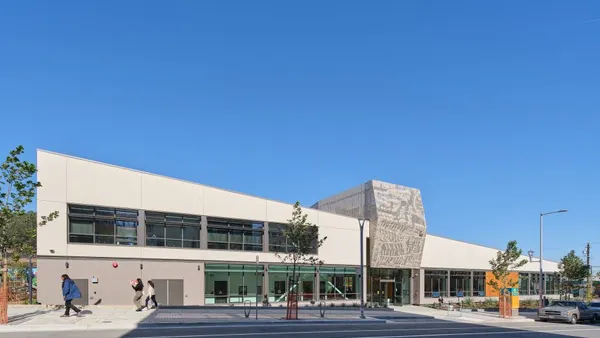The U.S. Green Building Council's Leadership in Energy and Environmental Design (LEED) certifications and other sustainability standards have come to be expected by building owners, businesses and consumers. And while contractors and their customers may not be eager to add to project costs, Dodge Data & Analytics' World Green Building Trends 2016 SmartMarket Report found that green construction methods increase a building's value by 4%.
The following companies are the leading green building contractors by design revenue, per Engineering News-Record's Top 100 Green Building Contractors list. These firms are implementing sustainable practices across their projects and company culture to not only minimize their environmental impact but also to attain competitive advantage amid growing public prioritization of climate change mitigation and corporate governance.
1. Turner Corp.
Green design revenue: $5.5 billion
Key project: The Weed Army Community Hospital in Fort Irwin, California, is the U.S. Department of Defense’s only LEED Platinum, carbon-neutral, net-zero hospital. Designed by the joint venture of AECOM and RLF for the Army Corps of Engineers, the facility includes a solar field, 550,000-gallon water tank and enough diesel storage to be wholly self-sufficient for two weeks if utilities were cut off.
Best practice: “Turner staff are continually challenged to remain knowledgeable on policies, best practices, trends and innovation related to sustainability in the built environment,” said Julia Gisewite, director of sustainability, as well as to stay up to date on the newest green rating systems on the market.
2. Clark Construction
Green design revenue: $4 billion
Key project: The 43-story Park Tower at Transbay is pre-certified LEED Gold and slated for completion this quarter. In addition to efficient building systems and raised floors, the high-rise features an open-air lobby, sky decks, green space and natural lighting. The tower, which is across the street from the Transbay Transit Center, has reportedly been fully leased by Facebook.
Best practice: Clark uses virtual design and construction technology to better advise clients and design partners on ways to optimize buildings for sustainability. The contractor also analyzes big data on building performance to drive better decision-making.
3. AECOM
Green design revenue: $3.8 billion
Key project: AECOM Tishman was construction manager for the 55-story One Bryant Park office tower in New York City, the world’s first high-rise to achieve LEED Platinum certification. The building includes a cogeneration plant (providing both heat and power), graywater systems, green roof areas and other sustainable features.
Best practice: AECOM “[embeds] sustainability and high-performance building experts within the design process,” said Claire Bonham-Carter, director of sustainable development for AECOM’s Buildings and Places business line. The company emphasizes strong collaboration from the project outset and uses "advanced modeling methods” from concepts to commissioning, she added.
4. Swinerton
Green design revenue: $2.9 billion
Key project: Swinerton was general contractor for a renovation of a former big-box retailer's building to create Google’s Boulder, Colorado, campus. The LEED Gold-certified building harvests natural lights through Solatubes and features energy-recovery HVAC units and low-VOC materials, ENR reported.
Best practice: The contractor formed Swinerton Renewable Energy 10 years ago to expand its sustainable energy offerings in the U.S. and abroad. It developed an app called Sunscreen, which helps streamline reporting and schedule management for renewable energy projects.
5. Hensel Phelps
Green design revenue: $2.3 billion
Key project: Hensel Phelps was general contractor on the LEED Platinum-certified Kaiser Permanente San Diego Medical Center, which includes energy-saving features like LED lighting, chilled-beam heating and cooling, a microturbine-based trigeneration plant and a 325-kilowatt solar photovoltaic canopy, ENR reported.
Best practice: The contractor focuses on reducing its own carbon footprint by using hybrid vehicles, recycling and waste material sorting, and workplaces that are LEED Silver, Gold or Platinum certified, so that even projects that aren’t targeting sustainability goals produce less of an environmental impact.
6. Skanska
Green design revenue: $2.2 billion
Key project: Skanska led construction on 101 Seaport, a LEED Platinum-certified tower on the Boston waterfront that uses about 50% less energy and 40% less water than the LEED baseline, which represents the average U.S. commercial project, the contractor says. About a quarter of the construction materials were sourced locally, while landscaping and underground parking aim to reduce the city’s heat island effect.
Best practice: Skanska recently developed a tool that quantifies a project's embodied carbon (associated with the building's materials), recognizing that this measure often receives less attention than operational energy and carbon but is equally important to "bend the carbon curve down," Chief Sustainability Officer Elizabeth Heider told Construction Dive. EC3, which will be publicly released in 2019, is an interactive tool that helps stakeholders "balance out [their] project in a way that will reduce the embodied carbon," she said.
7. Lendlease
Green design revenue: $2.1 billion
8. Holder Construction
Green design revenue: $1.8 billion
Key project: Holder was GC on 24th at Camelback Phase II, a high-rise office building in Phoenix, Arizona, which received LEED Gold certification for the base building and existing operations. Energy and water efficiency are "showcased to tenants in practical ways to reduce the building and occupant impacts to the environment," according to the company's website.
Best practice: The contractor emphasizes well-thought-out design and purchasing choices with regard to sustainability, as well as a commitment to using recyclable materials and energy-saving systems across many of its projects.
9. Webcor
Green design revenue: $1.8 billion
Key project: Webcor's Moscone Convention Center expansion, slated for completion in December, is targeting LEED Platinum certification and would be the first convention center to receive this. The facility includes water recycling systems and San Francisco's largest rooftop solar array, which Webcor says will be sufficient to generate 20% of the building's needs.
Best practice: Webcor’s “Green Team” is comprised of employees from across the company who have volunteered to spearhead sustainability initiatives within their teams in operations and at all jobsites. The program encourages employees to think holistically and innovatively about ways to reduce environmental impact, Senior Sustainability Manager Jenelle Shapiro told Construction Dive, from major design elements down to water bottle use on the jobsite.
10. Walsh Group
Green design revenue: $1.6 billion
Key project: Walsh converted a warehouse into its own LEED Platinum headquarters, featuring rainwater harvesting, a green roof on 70% of the roof surface and with 95% recycled construction materials. Integrated HVAC and lighting controls coupled with a high-efficiency enclosure reduce annual energy costs by 42%, the company says.
Best practice: The contractor offers internal training and exam reimbursements to help all employees, including interns and co-ops, earn LEED Green Associate certification, according to a company spokesperson. Project teams also host workshops and lunch-and-learn programs with architects and engineers to bounce ideas and sustainability best practices off each other.













